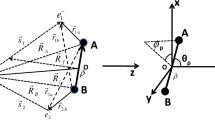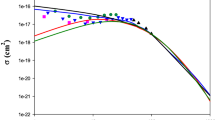Abstract
Theoretical investigations on state-selective total and angular differential cross sections for single-electron capture in collision of \(He^{+}\) with ground state helium atom has been presented within the framework of four-body distorted-wave model in the energy range of 30–4000 keV. In this model, distortions in the initial channel related to the Coulomb continuum states of the target and the active electron in the field of residual projectile ion are included. Here, the electron in the projectile plays the role of screening of the projectile ion. In this formalism, the dielectronic interaction \(\frac{1}{r_{12}}\) explicitly appears in the perturbation potential \(V_{i}\) of the prior form of transition amplitude. Moreover, we include the interaction of the projectile with the passive electron in the target in both prior and post forms of the transition amplitude. The main purpose of the present study is to investigate the relative importance of this interaction to the state-selective total as well as projectile angular-differential cross sections with impact energies. The angular-differential cross sections (DCS) for ground-state transfer exhibit an oscillatory structure at intermediate energies. This oscillatory structure demonstrates the analogy of atomic de Broglie’s matter-wave scattering with Fraunhofer-type diffraction of light waves. The present theoretical results are compared with the available experimental data as well as few theoretical calculations. We find that our computed results, particularly in the prior form, indicate better agreement with the experimental data than that of the post form. Post-prior discrepancy of the total cross sections does not exceed 25% throughout the energy range considered.
Similar content being viewed by others
References
R Gayet and J Hanssen J. Phys. B: At. Mol. Opt. Phys. 25 825 (1992)
Dz Belkic Phys. Scr. 45 35 (1992)
Dz Belkic, R Gayet, J Hanssen, I Mancev and A Nunez Phys. Rev. A 56 36750 (1997)
I Mancev Phys. Rev. A 75 052716 (2007)
I Mancev Eur. Phys. J. D 51 213 (2009)
I Mancev Phys. Scr. 51 762 (1995)
I Mancev Phys. Rev. A 54 423 (1996)
I Mancev J. Phys. B. 36 93 (2003)
I Mancev, V Mergel and L Schmidt, J. Phys. B 36 2733 (2003)
Dz Belkic Nucl. Instum. Methods Phys. Res. B 86 62 (1994)
Dz Belkic, I Mancev and M Mudrinic Phys. Rev. A 49 3646 (1994)
S Jana, R Samanta and M Purkait Nucl. Instum. Methods Phys. B 285 37 (2012)
R Samanta, S Jana, C R Mandal and M Purkait Phys. Rev. A 85 085201 (2012)
S Jana and M Purkait Indian J. Phys. 88 343 (2014)
S Jana and M Purkait Indian J. Phys. 89 641 (2015)
M Baxter, T Kirchner and E Engel Phys. Rev. A 96 032708 (2017)
Dz Belkic, R Gayet and A Salin Phys. Rep. 56 279 (1979)
R D\(\ddot{o}\)rner, V Mergel, O Jagutzki, L Spielberger, J Ullrich, R Moshammer and H Schmidt-Bocking Phys. Rep. 330 95 (2000)
J Ullrich, R Moshammer, A Dorn R D\(\ddot{o}\)rner, L Ph H Schmidt and H Schmidt-Bocking Rep. Prog. Phys. 66 1463 (2003)
D Fischer et al Phys. Rev. A 81 012714 (2010)
V Mergel et al Phys. Rev. Lett. 79 387 (1997)
N C Deb, A Jain and J H MaGuire Phys. Rev. A 38 3709 (1988)
K Stochkel et al Phys. Rev. A 72 050703 (2005)
D Misra et al Phys. Rev. Lett. 102 153201 (2009)
M S Sch\(\ddot{o}\)ffler et al Phys. Rev. A 79 064701 (2009)
I Mancev J. Comput. Methods. Sci. Eng. 5 71 (2005)
Q Wang, X Ma, X L Zhu and S F Zhang J. Phys. B: At. Mol. Opt. Phys. 45 025202 (2012)
Van der Poel et al Phys. Rev. Lett. 87 123201 (2001)
Van der Poel et al J. Phys. B: At. Mol. Opt. Phys. 35, 4491 (2002)
H Agueny Phys. Rev. A 92 012702 (2015)
J W Gao, Y Wu, J G Wang, N Sisourat and A Dubois Phys. Rev. A 97 052709 (2018)
J Gao, Z Hu, Y Wu, J Wang, N Sisourat and A Dubois Matter Radiat. Extremes 6 014404 (2021)
D L Guo et al Phys. Rev. A 95 012707 (2017)
R Okasaka, K Kawabe, S Kawamoto, M Tani, H Kuma, T Iwai, K Mita and A I Wamae Phys. Rev. A 49 246 (1994)
R Hippler, K H Schartner and H. F. Beyer J. Phys. B 11 L337 (1978)
T G Winter and C C Lin Phys. Rev. A 12 434 (1975)
R Hildenbrand, N Grun, W Scheid J. Phys. B 28 4781 (1999)
S Samaddar, D Jana, K Purkait and M Purkait J. Phys. B: At. Mol. Opt. Phys. 53 245202 (2020)
E Clementi and C Roetti At. Data Nucl Data Tables 14 177 (1974)
R R Lewis Phys. Rev. 102 537 (1956)
F W Byron and C J Joachain Phys. Rev. 146 1 (1966)
R D DuBois Phys. Rev. A 39 4440 (1989)
N V de Castro Faria, F L Freire and A G de Pinho Phys. Rev. A 37 280 (1988)
L Wolterbeek Muller and F J De Heer Physica 48 345 (1970)
L H Thomas Proc. R. Soc. 114 561 (1927)
E Horsdal-Pedersen, C L Cocke and M Stockli Phys. Rev. Lett. 50 1910 (1983)
F Trager Springer handbook of Lasers and Optics (Berlin: Springer )
M Born and E Wolf Principles of Optics : Electromagnetic Theory of Propagation, Interference and Diffraction of Light, 7th edition (Cambridge : Cambridge University Press) pp 421 (2003)
Acknowledgements
Thanks to Professor C. R. Mandal for helpful discussions and a critical review of the paper. K. Purkait is supported by a scholarship (239(Sanc.)/ST/P/S & T/16G-48/2017), West Bengal. This work was supported by the Science and Engineering Research Board (SERB), New Delhi, India, under Grant No. CRG/2018/001344. The authors also thank to M. S. Sch\(\ddot{o}\)ffler and J. W. Gao for communication through their experimental and theoretical data.
Author information
Authors and Affiliations
Corresponding author
Additional information
Publisher's Note
Springer Nature remains neutral with regard to jurisdictional claims in published maps and institutional affiliations.
Appendices
Appendices
Using the integral representation for the confluent hypergeometric function
the transition amplitude of Eq. (3) in the main text may be written as
where
and
in which the form of \(\mathscr {I}_{S}\)(\(S=R, x_{1}, x_{2}, r_{12}, s_{2}\)) reads
where \(\beta _{2}=\delta _{2}\), \(\lambda _{1}=\gamma _{1}+Z_{P}\), \(\lambda _{2}=\gamma _{2}-ivt_{1}\), \(\epsilon =\epsilon _{i}-ik_{i}t_{2}\), \(\epsilon _{i}, \delta _{i}\rightarrow 0\).
The value of \(\epsilon _{i}=2\delta _{2}\) for the evaluation of \(\mathscr {I}_{R}^{\prime }\). The \(\delta _{2}\) (\(\gamma _{1}\) and \(\gamma _{2}\)) are the orbital component of the initial (final) bound state wavefunctions. The constant \(N_{b}\) originates from the initial (\(\phi _{P}(\vec {s}_{1}\)) and \(\phi _{T}(\vec {x}_{2})\)) and final (\(\phi _{f}(\vec {s}_{1}, \vec {s}_{2})\)) bound-state wavefunctions.
The integral over \(\vec {S}\)
applying the integral identity
employing the expression
for \(S=(\vec {x}_{1}, \vec {r}_{12})\), applying Feynman parameterization integral
and applying the integral representation of three denominator integral of Lewis [40], the Eq. (10) may be reduced as
and
To evaluate the \(V_{S}(R)\) i.e., \(\mathscr {I}_{R}^{\prime }\) for both the prior and post forms, the operator may be written as
where, \(\mathscr {I}_{S}=\int _{0}^{\infty }k dy\), \(\mathscr {I}_{S}^{\prime }=\int _{0}^{1}dt \int _{0}^{\infty }\frac{k}{\Delta } ds\),
and
Here \(\sigma _{0}\), \(\sigma _{1}\), \(\sigma _{2}\) and \(\sigma _{3}\) are functions of the momentum vectors, the orbital components of bound state, the velocity, the integration variables (t and s) and the projectile scattering angle. \(\mathscr {I}_{S}\) in Eqs. (17)–(19) contain one-dimensional Lewis integral, wheras \(\mathscr {I}_{S}^{\prime }\) in this equations contain two-dimensional integrals such as Lewis and Feynman integral. The Lewis integral with infinite upper limit and the Feynmen integral from 0 to 1 have been performed numerically by Gauss-Legendre quadrature method. It is mentioned that for the terms \(\frac{1}{r_{12}}\) and \(\frac{1}{x_{1}}\) in the perturbation potential, an additional one-dimensional integral over \(t\epsilon (0,1)\) is needed.
Ground state total cross sections as a function of laboratory incident energy E (keV) for the reaction \(He^{+}+He(1s^{2})\rightarrow He(1s^{2})+He^{+}\). Theory: The full and dashed dark lines represent the results of present DW-4B method in prior and post forms using complete perturbation potential. The dashed blue lines represents the prior DW-4B without \(V_{S}(R)\). The dotted green line represent the results of Gao et al. [31] using semi-classical atomic-orbital close-coupling method (SCAOCC); red dash-dotted line, CDW-4B results of Mancev [4]; violet dash-dotted line, dCTMC results of Guo et al. [33]. Experiments : filled triangle, results of Guo et al. [33], filled circle DuBois [42] and filled red square, results of de Castro Faria et al. [43]
Cross sections for single-electron transfer to final state \(He(1s2s {^{1}}{} \mathbf{S}\), \(1s2p {^{1}}{} \mathbf{P}\) and \(1s3s {^{1}}{} \mathbf{S} )\) as a function of the projectile energy. Theory: The full and dashed dark lines represent the prior and post results; dashed blue line, prior results without \(V_{s}(R)\); dash-dotted violet line, results of Winter and Lin [36]; dotted red line, Hildenbrand et al. [37]; dotted green line SCAOCC results of Gao et al. [31]. Experiments: filled square, results of Okasaka et al. [34]; filled circle, results of Hippler et al. [35] and filled triangle, results of Muller and Heer et al. [44]
Differential cross sections as a function of projectile scattering angle \(\theta _{P}\) (radian) in the laboratory frame of reference for single electron transfer to the ground state in \(He^{+}\)–He collisions at 30, 100, 240, 600 and 2520 keV. Theory: The full and dashed curves represent the present result in prior form with and without \(V_{S}(R)\); red dotted curve, SCAOCC results [31]; blue dotted curve, CDW-BIS results [25]. Experiments: filled dark circle, results of Sch\(\ddot{o}\)ffler et al. [25] and filled red circle, results of Guo et al. [33]
Ground state transfer angular-differential cross sections weighted by \(\sin {\theta _{p}}\) as a function of projectile scattering angle at impact energies 30, 100, 240, 600 and 2520 keV. Theory: The full and dashed curve represents the present prior results with and without \(V_{S}(R)\) in the perturbation potential; green dotted curve, results of Gao et al. [31]. Experiments: filled dark circle, results of Sch\(\ddot{o}\)ffler et al. [25] and filled red circle, results of Guo et al. [33]
Rights and permissions
About this article
Cite this article
Jana, D., Purkait, K., Haque, A. et al. State-selective differential and total cross sections for single-electron capture in \(He^{+}\)–He collisions. Indian J Phys 96, 4071–4081 (2022). https://doi.org/10.1007/s12648-022-02353-9
Received:
Accepted:
Published:
Issue Date:
DOI: https://doi.org/10.1007/s12648-022-02353-9








